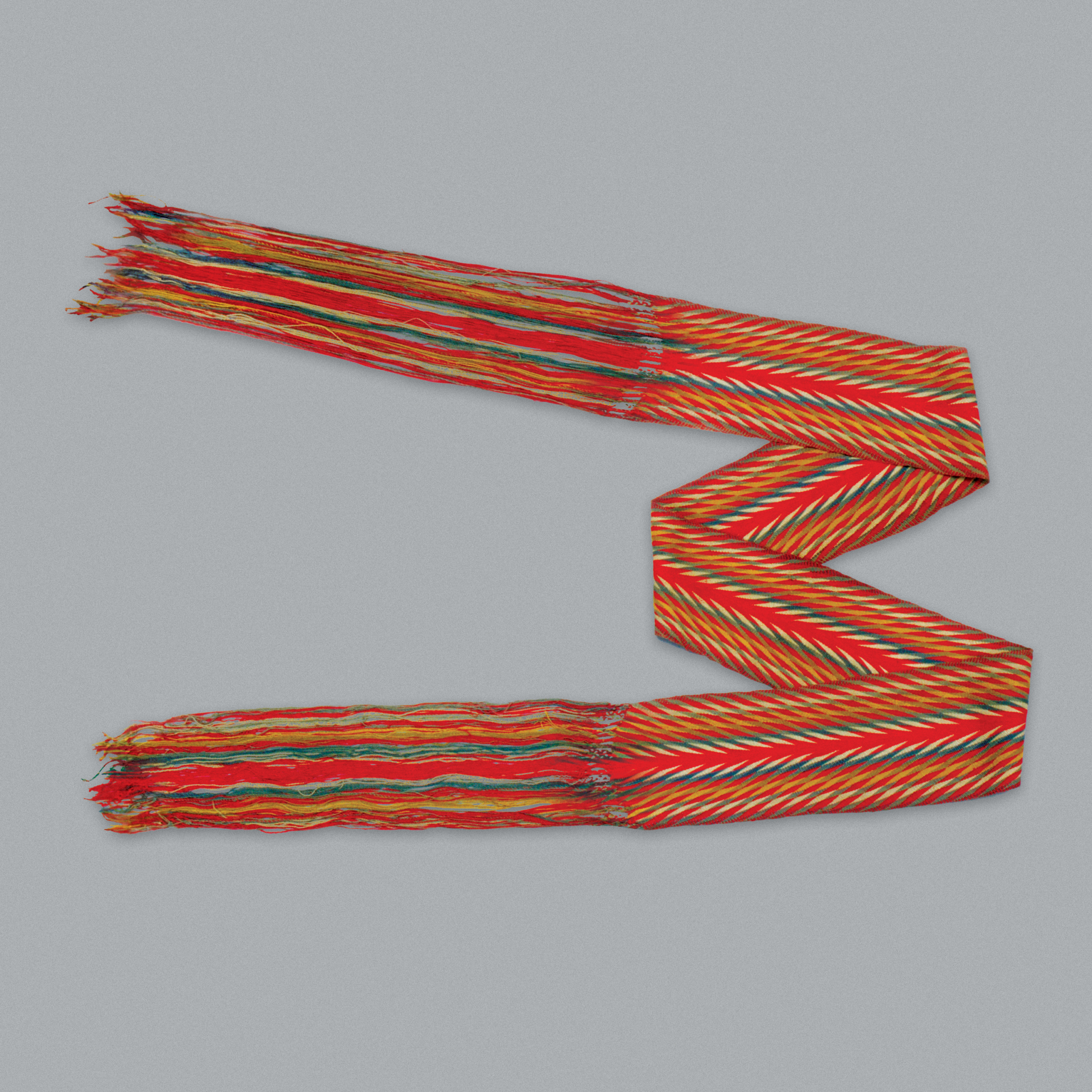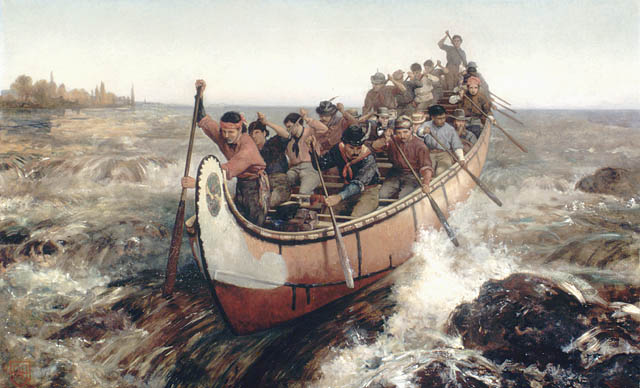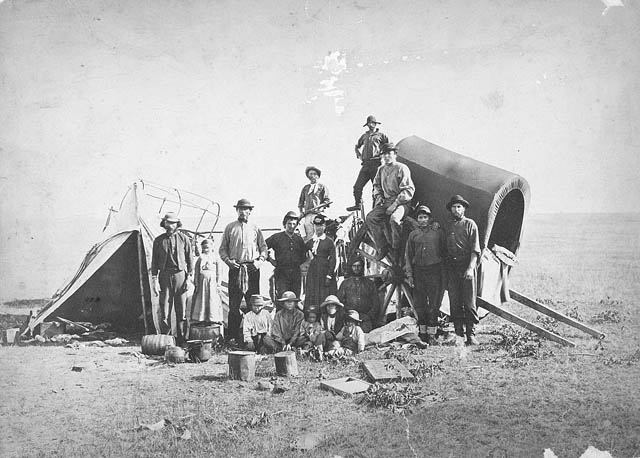Ceinture Fléchée
Artifact
Image
Video
Audio
 Activities
Activities
LOOK
Look closely at this object. What do you think its purpose is? Verify your answer by reading the Historical Context below.
THINK
Why do you think the ceinture fléchée is an important symbol for French Canadian and Métis people? Use historical evidence found in the Historical Context below to support your answer.
Details
 Materials
Materials - Wool
Historical Context
Choose one of the three levels below to match your needs.
- This is a ceinture fléchée: a colourful finger-woven sash, worn by Canadiens (French Canadians) and some Indigenous peoples since at least the early 1800s.
- A ceinture fléchée can be used to help carry heavy loads, to keep a coat fastened in the winter or even to bandage a wound.
- The ceinture fléchée became an important symbol of identity for Canadiens, who were later known as French Canadians or Québécois.
Scroll through the media carousel above to see a painting of voyageurs and a photograph of a group of Métis, some of whom are wearing a ceinture fléchée.
This is a ceinture fléchée: a colourful finger-woven sash, worn by Canadiens (French Canadians) and some Indigenous peoples since at least the early 1800s. More than a piece of clothing, a ceinture fléchée can be used to help carry heavy loads, to keep a coat fastened in the winter or even to bandage a wound.
Some Canadiens — particularly those involved in the fur trade — wore ceintures fléchées for back support while paddling and portaging canoes, and also used them as bandanas, harnesses, tow ropes and tourniquets.
By the 1780s, a home industry of sash weaving was developing in the Lower Canada parish of L’Assomption. Using a finger weaving (non-loom) technique, parish weavers made dyed woollen sashes as a domestic craft and utilitarian art form.
The ceinture fléchée became an important symbol of identity for Canadiens, who were later known as French Canadians or Québécois.
This is a ceinture fléchée: a colourful finger-woven sash, worn by Canadiens (French Canadians) and some Indigenous peoples since at least the early 1800s. More than a piece of clothing, a ceinture fléchée can be used to help carry heavy loads, to keep a coat fastened during the winter, or even to bandage a wound.
By the 1780s, a home-based sash-weaving industry was developing in the Lower Canada parish of L’Assomption (and particularly in its subdivisions Saint-Jacques-de-l’Achigan and Sainte-Marie-Salomé). Using a finger-weaving (non-loom) technique, parish weavers made dyed woolen sashes as a domestic craft and utilitarian art form.
By the 1830s, weavers were producing variations on a standard pattern that featured a central red band — or “cœur” (heart) — running from one end of the sash to the other. The sashes also had barbed edges at each end, resembling a series of arrows (flèches in French), which is how the sash got the name “fléchée.” On either side of this central core, there was a series of parallel zigzags, chevrons or “éclairs” (lightning bolts) in various colours.
Some Canadiens — particularly those involved in the fur trade — wore ceintures fléchées for back support while paddling and portaging canoes. In addition, they used the sashes as bandanas, harnesses, tow ropes and tourniquets. The unwoven fringes on the sash also provided a ready supply of thread for mending torn garments.
Indigenous finger weaving in the St. Lawrence Lowlands and Great Lakes-riverine areas incorporated distinctive designs and materials as well. Haudenosaunee, Huron-Wendat and Anishinaabe sashes, for example, often featured parallel rows of glass beads.
The ceinture fléchée became an important symbol of identity for Canadiens, who were later known as French Canadians or Québécois.
- This is a ceinture fléchée: a colourful finger-woven sash, worn by Canadiens (French Canadians) and some Indigenous peoples since at least the early 1800s.
- A ceinture fléchée can be used to help carry heavy loads, to keep a coat fastened in the winter or even to bandage a wound.
- The ceinture fléchée became an important symbol of identity for Canadiens, who were later known as French Canadians or Québécois.
Scroll through the media carousel above to see a painting of voyageurs and a photograph of a group of Métis, some of whom are wearing a ceinture fléchée.
This is a ceinture fléchée: a colourful finger-woven sash, worn by Canadiens (French Canadians) and some Indigenous peoples since at least the early 1800s. More than a piece of clothing, a ceinture fléchée can be used to help carry heavy loads, to keep a coat fastened in the winter or even to bandage a wound.
Some Canadiens — particularly those involved in the fur trade — wore ceintures fléchées for back support while paddling and portaging canoes, and also used them as bandanas, harnesses, tow ropes and tourniquets.
By the 1780s, a home industry of sash weaving was developing in the Lower Canada parish of L’Assomption. Using a finger weaving (non-loom) technique, parish weavers made dyed woollen sashes as a domestic craft and utilitarian art form.
The ceinture fléchée became an important symbol of identity for Canadiens, who were later known as French Canadians or Québécois.
This is a ceinture fléchée: a colourful finger-woven sash, worn by Canadiens (French Canadians) and some Indigenous peoples since at least the early 1800s. More than a piece of clothing, a ceinture fléchée can be used to help carry heavy loads, to keep a coat fastened during the winter, or even to bandage a wound.
By the 1780s, a home-based sash-weaving industry was developing in the Lower Canada parish of L’Assomption (and particularly in its subdivisions Saint-Jacques-de-l’Achigan and Sainte-Marie-Salomé). Using a finger-weaving (non-loom) technique, parish weavers made dyed woolen sashes as a domestic craft and utilitarian art form.
By the 1830s, weavers were producing variations on a standard pattern that featured a central red band — or “cœur” (heart) — running from one end of the sash to the other. The sashes also had barbed edges at each end, resembling a series of arrows (flèches in French), which is how the sash got the name “fléchée.” On either side of this central core, there was a series of parallel zigzags, chevrons or “éclairs” (lightning bolts) in various colours.
Some Canadiens — particularly those involved in the fur trade — wore ceintures fléchées for back support while paddling and portaging canoes. In addition, they used the sashes as bandanas, harnesses, tow ropes and tourniquets. The unwoven fringes on the sash also provided a ready supply of thread for mending torn garments.
Indigenous finger weaving in the St. Lawrence Lowlands and Great Lakes-riverine areas incorporated distinctive designs and materials as well. Haudenosaunee, Huron-Wendat and Anishinaabe sashes, for example, often featured parallel rows of glass beads.
The ceinture fléchée became an important symbol of identity for Canadiens, who were later known as French Canadians or Québécois.
Summary
- This is a ceinture fléchée: a colourful finger-woven sash, worn by Canadiens (French Canadians) and some Indigenous peoples since at least the early 1800s.
- A ceinture fléchée can be used to help carry heavy loads, to keep a coat fastened in the winter or even to bandage a wound.
- The ceinture fléchée became an important symbol of identity for Canadiens, who were later known as French Canadians or Québécois.
Scroll through the media carousel above to see a painting of voyageurs and a photograph of a group of Métis, some of whom are wearing a ceinture fléchée.
Essential
This is a ceinture fléchée: a colourful finger-woven sash, worn by Canadiens (French Canadians) and some Indigenous peoples since at least the early 1800s. More than a piece of clothing, a ceinture fléchée can be used to help carry heavy loads, to keep a coat fastened in the winter or even to bandage a wound.
Some Canadiens — particularly those involved in the fur trade — wore ceintures fléchées for back support while paddling and portaging canoes, and also used them as bandanas, harnesses, tow ropes and tourniquets.
By the 1780s, a home industry of sash weaving was developing in the Lower Canada parish of L’Assomption. Using a finger weaving (non-loom) technique, parish weavers made dyed woollen sashes as a domestic craft and utilitarian art form.
The ceinture fléchée became an important symbol of identity for Canadiens, who were later known as French Canadians or Québécois.
In-Depth
This is a ceinture fléchée: a colourful finger-woven sash, worn by Canadiens (French Canadians) and some Indigenous peoples since at least the early 1800s. More than a piece of clothing, a ceinture fléchée can be used to help carry heavy loads, to keep a coat fastened during the winter, or even to bandage a wound.
By the 1780s, a home-based sash-weaving industry was developing in the Lower Canada parish of L’Assomption (and particularly in its subdivisions Saint-Jacques-de-l’Achigan and Sainte-Marie-Salomé). Using a finger-weaving (non-loom) technique, parish weavers made dyed woolen sashes as a domestic craft and utilitarian art form.
By the 1830s, weavers were producing variations on a standard pattern that featured a central red band — or “cœur” (heart) — running from one end of the sash to the other. The sashes also had barbed edges at each end, resembling a series of arrows (flèches in French), which is how the sash got the name “fléchée.” On either side of this central core, there was a series of parallel zigzags, chevrons or “éclairs” (lightning bolts) in various colours.
Some Canadiens — particularly those involved in the fur trade — wore ceintures fléchées for back support while paddling and portaging canoes. In addition, they used the sashes as bandanas, harnesses, tow ropes and tourniquets. The unwoven fringes on the sash also provided a ready supply of thread for mending torn garments.
Indigenous finger weaving in the St. Lawrence Lowlands and Great Lakes-riverine areas incorporated distinctive designs and materials as well. Haudenosaunee, Huron-Wendat and Anishinaabe sashes, for example, often featured parallel rows of glass beads.
The ceinture fléchée became an important symbol of identity for Canadiens, who were later known as French Canadians or Québécois.



